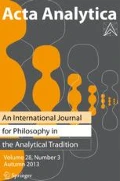Abstract
Ruth Millikan’s teleological theory of mental content is complex and often misunderstood. This paper motivates and clarifies some of the complexities of the theory, and shows that paying careful attention to its details yields answers to a number of common objections to teleological theories, in particular, the problem of novel mental states, the problem of functionally false beliefs, and problems about indeterminacy or multiplicity of function.
Similar content being viewed by others
References
Fodor, J. A. 1975: The Language of Thought. Thomas Y. Crowell Company, New York.
Fodor, J. A. 1990: “A Theory of Content I: The Problem,” in A Theory of Content and Other Essays. MIT Press, Cambridge, Mass., 51–87.
Fodor, J. A. 1991: “Replies.” In Loewer and Rey (eds) 1991, 255–319.
Godfrey-Smith, P. 1988: Review of Language, Thought and Other Biological Categories. Australasian Journal of Philosophy 66, 556–560.
Godfrey-Smith, P. 1989: “Misinformation.” Canadian Journal of Philosophy 19, 533–550.
Griffiths, P. 1993: “Functional Analysis and Proper Functions.” British Journal of the Philosophy of Science 44, 409–422.
Millikan, R. 1984: Language, Thought and Other Biological Categories. MIT Press, Cambridge, Mass.
Millikan, R. 1986: “Thoughts Without Laws; Cognitive Science With Content.” Philosophical Review 95, 47–80, reprinted in Millikan 1995.
Millikan, R. 1989: “Biosemantics.” Journal of Philosophy 86, 281–297, reprinted in Millikan 1995.
Millikan, R. 1990: “Compare and Contrast Dretske, Millikan and Fodor on Teleosemantics.” Philosophical Topics 18, 151–161, reprinted in Millikan 1995.
Millikan, R. 1995: White Queen Psychology and Other Essays for Alice. MIT Press, Cambridge, Mass.
Neander, K. 1991: “Functions as Selected Effects: The Conceptual Analyst’s Defense.” Philosophy of Science 58, 168–184.
Papineau, D. 1987: Reality and Representation. Basil Blackwell, Oxford.
Papineau, D. 1993: Philosophical Naturalism. Basil Blackwell, Cambridge, Mass.
Papineau, D. 1998: “Teleosemantics and Indeterminacy.” Australasian Journal of Philosophy 76, 1998, 1–14.
Price, Carolyn, 2001: Functions in Mind: A Theory of Intentional Content. Clarendon Press, Oxford.
Sterelny, K. 1990: The Representational Theory of Mind. Basil Blackwell, Oxford.
Taylor, S., Collins, R., Skokan, L. and Aspinwall, L., 1989: “Maintaining Positive Illusions in the Face of Negative Information: Getting the Facts Without Letting Them Get To You.” Journal of Social and Clinical Psychology 8, 114–129.
Author information
Authors and Affiliations
Rights and permissions
About this article
Cite this article
Kingsbury, J. A proper understanding of Millikan. Acta Anal 21, 23–40 (2006). https://doi.org/10.1007/s12136-006-1008-8
Received:
Issue Date:
DOI: https://doi.org/10.1007/s12136-006-1008-8




